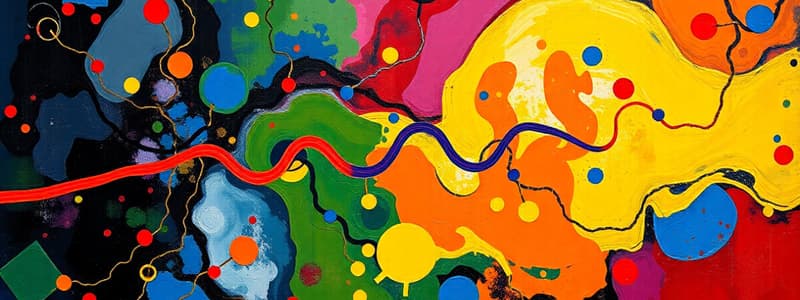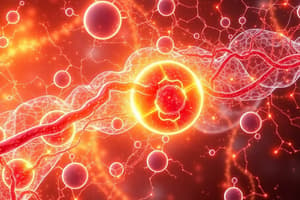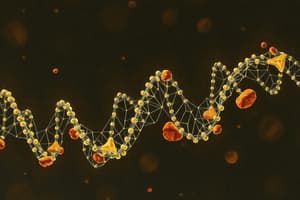Podcast
Questions and Answers
What is the name of the metabolic pathway used by mitochondria to produce ATP?
What is the name of the metabolic pathway used by mitochondria to produce ATP?
Oxidative Phosphorylation
Oxidative phosphorylation is a process occurring only in anaerobic organisms.
Oxidative phosphorylation is a process occurring only in anaerobic organisms.
False (B)
What is the primary molecule used by cells to supply energy to metabolism?
What is the primary molecule used by cells to supply energy to metabolism?
ATP
Who is credited with discovering the vital role of phosphate in cellular fermentation in 1906?
Who is credited with discovering the vital role of phosphate in cellular fermentation in 1906?
Which scientist confirmed in 1941 the central role of ATP in energy transfer?
Which scientist confirmed in 1941 the central role of ATP in energy transfer?
Which of the following metabolic pathways are linked to ATP synthesis?
Which of the following metabolic pathways are linked to ATP synthesis?
Oxidative phosphorylation is less efficient in energy release compared to anaerobic glycolysis.
Oxidative phosphorylation is less efficient in energy release compared to anaerobic glycolysis.
What is the name of the process by which ATP is formed in the electron transport chain (ETC)?
What is the name of the process by which ATP is formed in the electron transport chain (ETC)?
Which of the following molecules are oxidized during the electron transport chain, releasing energy for ATP production?
Which of the following molecules are oxidized during the electron transport chain, releasing energy for ATP production?
Match the following complexes with their roles in the electron transport chain.
Match the following complexes with their roles in the electron transport chain.
What is the role of ubiquinone in the ETC?
What is the role of ubiquinone in the ETC?
Which complex in the ETC is responsible for pumping protons across the membrane, contributing to the proton gradient?
Which complex in the ETC is responsible for pumping protons across the membrane, contributing to the proton gradient?
Which complex in the ETC is directly involved in both the citric acid cycle and the electron transport chain?
Which complex in the ETC is directly involved in both the citric acid cycle and the electron transport chain?
Complex II, similar to complex I, contributes to the proton gradient by transporting protons across the membrane.
Complex II, similar to complex I, contributes to the proton gradient by transporting protons across the membrane.
What is the name of the enzyme that operates in reverse to complex II in some eukaryotes like the parasitic worm Ascaris suum?
What is the name of the enzyme that operates in reverse to complex II in some eukaryotes like the parasitic worm Ascaris suum?
Cytochrome c carries two electrons, similar to ubiquinone.
Cytochrome c carries two electrons, similar to ubiquinone.
Which complex in the ETC receives electrons from cytochrome c and transfers them to oxygen?
Which complex in the ETC receives electrons from cytochrome c and transfers them to oxygen?
Cytochrome c oxidase is located in the mitochondrial matrix.
Cytochrome c oxidase is located in the mitochondrial matrix.
Cytochrome c oxidase has a simpler structure compared to other complexes in the ETC.
Cytochrome c oxidase has a simpler structure compared to other complexes in the ETC.
What is the name of the complex responsible for ATP synthesis in the ETC?
What is the name of the complex responsible for ATP synthesis in the ETC?
Which of the following subunits is NOT part of the F1 portion of ATP Synthase?
Which of the following subunits is NOT part of the F1 portion of ATP Synthase?
Only the β subunits in the F1 portion of ATP Synthase are responsible for catalyzing the ATP synthesis reaction?
Only the β subunits in the F1 portion of ATP Synthase are responsible for catalyzing the ATP synthesis reaction?
In some bacteria and archaea, ATP synthesis is driven by the movement of sodium ions instead of protons.
In some bacteria and archaea, ATP synthesis is driven by the movement of sodium ions instead of protons.
What is the name of the alternative enzyme that oxidizes NADH in the cytosol of some eukaryotic organisms?
What is the name of the alternative enzyme that oxidizes NADH in the cytosol of some eukaryotic organisms?
The alternative oxidase found in some organisms transfers electrons directly from ubiquinol to oxygen.
The alternative oxidase found in some organisms transfers electrons directly from ubiquinol to oxygen.
Prokaryotes can only utilize specific substances to donate or accept electrons in the electron transport chain.
Prokaryotes can only utilize specific substances to donate or accept electrons in the electron transport chain.
Which of the following molecules can inhibit oxidative phosphorylation by binding to cytochrome c oxidase?
Which of the following molecules can inhibit oxidative phosphorylation by binding to cytochrome c oxidase?
Which antibiotic inhibits ATP synthase by blocking the flow of protons through its F0 subunit?
Which antibiotic inhibits ATP synthase by blocking the flow of protons through its F0 subunit?
What is the name of the ionophore that uncouples proton pumping from ATP synthesis by carrying protons across the inner mitochondrial membrane?
What is the name of the ionophore that uncouples proton pumping from ATP synthesis by carrying protons across the inner mitochondrial membrane?
Rotenone, a pesticide, inhibits the transfer of electrons from complex I to ubiquinone.
Rotenone, a pesticide, inhibits the transfer of electrons from complex I to ubiquinone.
What are the main types of energy coupling processes?
What are the main types of energy coupling processes?
In an exergonic reaction, the free-energy change (ΔG) is positive.
In an exergonic reaction, the free-energy change (ΔG) is positive.
Flashcards
Oxidative Phosphorylation (OXPHOS)
Oxidative Phosphorylation (OXPHOS)
A metabolic pathway where mitochondria use their structure, enzymes, and energy from nutrient oxidation to produce ATP, the universal energy currency of cells.
Electron Transport Chain (ETC)
Electron Transport Chain (ETC)
Process in which NADH and FADH2, produced during glycolysis and other metabolic pathways, are oxidized, releasing energy to generate ATP.
NADH-coenzyme ubiquinone oxidoreductase (Complex I)
NADH-coenzyme ubiquinone oxidoreductase (Complex I)
An integral protein that receives electrons from NADH and passes them to ubiquinone. It pumps protons from the mitochondrial matrix to the intermembrane space.
Succinate-Q oxidoreductase (Complex II)
Succinate-Q oxidoreductase (Complex II)
Signup and view all the flashcards
Q-cytochrome c oxidoreductase (Complex III)
Q-cytochrome c oxidoreductase (Complex III)
Signup and view all the flashcards
Cytochrome c oxidase (Complex IV)
Cytochrome c oxidase (Complex IV)
Signup and view all the flashcards
ATP Synthase (Complex V)
ATP Synthase (Complex V)
Signup and view all the flashcards
Exergonic Reaction
Exergonic Reaction
Signup and view all the flashcards
Endergonic Reaction
Endergonic Reaction
Signup and view all the flashcards
NAD+ (Nicotinamide adenine dinucleotide)
NAD+ (Nicotinamide adenine dinucleotide)
Signup and view all the flashcards
NADP+ (Nicotinamide adenine dinucleotide phosphate)
NADP+ (Nicotinamide adenine dinucleotide phosphate)
Signup and view all the flashcards
FMN (Flavin Mononucleotide)
FMN (Flavin Mononucleotide)
Signup and view all the flashcards
FAD (Flavin Adenine Dinucleotide)
FAD (Flavin Adenine Dinucleotide)
Signup and view all the flashcards
Flavoprotein
Flavoprotein
Signup and view all the flashcards
Standard Reduction Potential (Eo)
Standard Reduction Potential (Eo)
Signup and view all the flashcards
Cryptochrome
Cryptochrome
Signup and view all the flashcards
Photolyase
Photolyase
Signup and view all the flashcards
Chemiosmotic Phosphorylation
Chemiosmotic Phosphorylation
Signup and view all the flashcards
Ionophore
Ionophore
Signup and view all the flashcards
Coupled Reaction
Coupled Reaction
Signup and view all the flashcards
Group Transfer
Group Transfer
Signup and view all the flashcards
Kinase
Kinase
Signup and view all the flashcards
Molecular Transducer
Molecular Transducer
Signup and view all the flashcards
Proton-motive force
Proton-motive force
Signup and view all the flashcards
Flagella Motion
Flagella Motion
Signup and view all the flashcards
Inhibitor
Inhibitor
Signup and view all the flashcards
Cyanide
Cyanide
Signup and view all the flashcards
Oligomycin
Oligomycin
Signup and view all the flashcards
CCCP (2,4-Dinitrophenol)
CCCP (2,4-Dinitrophenol)
Signup and view all the flashcards
Rotenone
Rotenone
Signup and view all the flashcards
Malonate and Oxaloacetate
Malonate and Oxaloacetate
Signup and view all the flashcards
Antimycin A
Antimycin A
Signup and view all the flashcards
Study Notes
Oxidative Phosphorylation
- Oxidative phosphorylation (OXPHOS) is a metabolic pathway in mitochondria.
- It uses energy released from nutrient oxidation to create ATP.
- All aerobic organisms use this pathway.
- In 1906, Arthur Harden's work showed phosphate's role in cellular fermentation.
- Later, it was established that ATP is crucial in energy transfer, as proposed by Fritz Albert Lipmann in 1941.
- Morris Friedkin and Albert L. Lehninger, in 1949, linked the citric acid cycle to ATP synthesis via NADH.
- This pathway is highly efficient, compared to alternative processes like anaerobic glycolysis.
Electron Transport Chain (ETC)
- The ETC uses NADH and FADH₂ produced in glycolysis, beta-oxidation and other catabolic processes.
- These processes are oxidized, releasing energy stored as ATP.
- Chemiosmotic phosphorylation is the mechanism by which ATP is formed via the ETC.
- The ETC is located in the inner mitochondrial membrane of eukaryotes and the plasma membrane of prokaryotes.
- Several protein complexes of electron carriers are involved, acting like a proton pump.
- The pumping of protons (H+) creates a proton gradient across the membrane.
NADH-coenzyme ubiquinone oxidoreductase (Complex I)
- An integral protein that transfers hydride ions from NADH to ubiquinone(Q10).
- The reaction involves NADH oxidation and ubiquinone reduction.
- Electrons enter complex I via FMN and then pass through iron-sulfur clusters.
- Four protons are pumped from the matrix to the intermembrane space during electron transfer.
Succinate-Q oxidoreductase (Complex II)
- A peripheral protein receiving electrons from succinate (TCA cycle intermediate).
- It oxidizes succinate to fumarate, forming FADH₂ in the process.
- Electrons are then transferred to ubiquinone.
- Unlike complex I, it does not transport protons across the membrane.
Electron transfer flavoprotein-ubiquinone oxidoreductase (ETF-Q oxidoreductase)
- Another entry point for the electron transport chain.
- It accepts electrons from electron-transferring flavoprotein, then transfers them to ubiquinone.
- This enzyme has a flavin and a [4Fe-4S] cluster.
- It is associated with the membrane surface, and doesn't cross the bilayer.
Q-cytochrome c oxidoreductase (Complex III)
- Receives electrons from ubiquinol.
- Oxidizes ubiquinol and reduces cytochrome c.
- Cytochrome c usually carries only one electron, unlike ubiquinone.
- Protons are pumped during this process.
Cytochrome c oxidase (Complex IV)
- Receives electrons from cytochrome c and transfers them to oxygen.
- Oxygen is reduced to water.
- Protons are also pumped during this step, contributing to the proton gradient.
ATP synthase (Complex V)
- Uses the proton gradient (chemiosmotic phosphorylation) for ATP synthesis from ADP and inorganic phosphate.
- The enzyme consists of F0 and F1 subunits.
- F0 forms a proton channel through the membrane.
- F1 is the catalytic portion where ATP is generated.
Coupled Reactions
- Exergonic reactions can drive endergonic (requires energy) ones.
- The hydrolysis of ATP to ADP and Pi is an exergonic process, which can be coupled with other reactions.
- The binding-change mechanism in ATP synthase involves a conformational change cycle.
- Group transfer reactions are very common in living cells, involve acyl, glycosyl, and phosphoryl groups, and facilitate conversions involving nucleophiles.
Inhibitors
- Various compounds inhibit oxidative phosphorylation at different stages.
- Cyanide and carbon monoxide bind tightly to complex IV, inhibiting oxygen reduction.
- Oligomycin blocks proton flow through ATP synthase.
- Dinitrophenol (DNP) uncouples the proton gradient from ATP synthesis.
Other Topics
- Alternative oxidases and reductases exist in different organisms, varying from mammals.
- Prokaryotes use different electron donors/acceptors and have various electron chain pathways.
- The midpoint potential of a chemical reflects its energy release during oxidation or reduction.
- Various enzymes play various roles and their roles and function in metabolism.
Studying That Suits You
Use AI to generate personalized quizzes and flashcards to suit your learning preferences.




